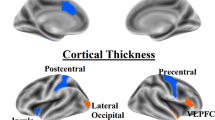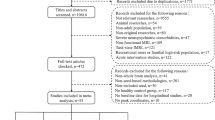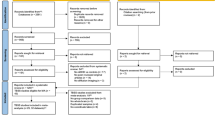Abstract
Aggression is widely observed in children with attention deficit/hyperactivity disorder (ADHD) and has been frequently linked to frustration or the unsatisfied anticipation of reward. Although animal studies and human functional neuroimaging implicate altered reward processing in aggressive behaviors, no previous studies have documented the relationship between fronto-accumbal circuitry—a critical cortical pathway to subcortical limbic regions—and aggression in medication-naive children with ADHD. To address this, we collected behavioral measures and parental reports of aggression and impulsivity, as well as structural and diffusion MRI, from 30 children with ADHD and 31 healthy controls (HC) (mean age, 10±2.1 SD). Using grey matter morphometry and probabilistic tractography combined with multivariate statistical modeling (partial least squares regression and support vector regression), we identified anomalies within the fronto-accumbal circuit in childhood ADHD, which were associated with increased aggression. More specifically, children with ADHD showed reduced right accumbal volumes and frontal-accumbal white matter connectivity compared with HC. The magnitude of the accumbal volume reductions within the ADHD group was significantly correlated with increased aggression, an effect mediated by the relationship between the accumbal volume and impulsivity. Furthermore, aggression, but not impulsivity, was significantly explained by multivariate measures of fronto-accumbal white matter connectivity and cortical thickness within the orbitofrontal cortex. Our multi-modal imaging, combined with multivariate statistical modeling, indicates that the fronto-accumbal circuit is an important substrate of aggression in children with ADHD. These findings suggest that strategies aimed at probing the fronto-accumbal circuit may be beneficial for the treatment of aggressive behaviors in childhood ADHD.
Similar content being viewed by others
Log in or create a free account to read this content
Gain free access to this article, as well as selected content from this journal and more on nature.com
or
References
Achenbach TM, Edelbrock C (1991). Child behavior checklist. Burlington 7.
Achenbach TM, Rescorla LA (2001) Manual for ASEBA School-Age Forms & Profiles University of Vermont. Research Center for Children, Youth, & Families: Burlington, VA.
Adcock RA, Thangavel A, Whitfield-Gabrieli S, Knutson B, Gabrieli JD (2006). Reward-motivated learning: mesolimbic activation precedes memory formation. Neuron 50: 507–517.
Alexander GE, Crutcher MD (1990). Functional architecture of basal ganglia circuits: neural substrates of parallel processing. Trend Neurosci 13: 266–271.
Austin N, Rogers L (2012). Limb preferences and lateralization of aggression, reactivity and vigilance in feral horses Equus caballus. Animal Behav 83: 239–247.
Behrens TE, Woolrich MW, Jenkinson M, Johansen-Berg H, Nunes RG, Clare S et al (2003). Characterization and propagation of uncertainty in diffusion-weighted MR imaging. Magn Reson Med 50: 1077–1088.
Bisazza A, de Santi A (2003). Lateralization of aggression in fish. Behav Brain Res 141: 131–136.
Blair R (2004). The roles of orbital frontal cortex in the modulation of antisocial behavior. Brain Cogn 55: 198–208.
Carmona S, Proal E, Hoekzema EA, Gispert J-D, Picado M, Moreno I et al (2009). Ventro-striatal reductions underpin symptoms of hyperactivity and impulsivity in attention-deficit/hyperactivity disorder. Biol Psychiatr 66: 972–977.
Cha J, Greenberg T, Carlson JM, DeDora DJ, Hajcak G, Mujica-Parodi LR (2014). Circuit-wide structural and functional measures predict ventromedial prefrontal cortex fear generalization: implications for generalized anxiety disorder. J Neurosci 34: 4043–4053.
Chang C-C, Lin C-J (2011). LIBSVM: a library for support vector machines. ACM Transact Intell Syst Technol 2: 27.
Chowdhury R, Lambert C, Dolan RJ, Duzel E (2013). Parcellation of the human substantia nigra based on anatomical connectivity to the striatum. Neuroimage 81: 191–198.
Conners C, Sitarenios G, Parker J, Epstein J (1998). The revised Conners' Parent Rating Scale (CPRS-R): factor structure, reliability, and criterion validity. J Abnormal Child Psychol 26: 257–268.
Conners CK, Staff M (2000) Conners' Continuous Performance Test II (CPT II V. 5). Multi-Health Systems: North Tonawanda, NY.
Connor DF, Glatt SJ, Lopez ID, Jackson D, Melloni RH Jr (2002). Psychopharmacology and aggression. I: A meta-analysis of stimulant effects on overt/covert aggression–related behaviors in ADHD. J Am Acadf Child Adolesc Psychiatr 41: 253–261.
Dale AM, Fischl B, Sereno MI (1999). Cortical surface-based analysis. I. Segmentation and surface reconstruction. Neuroimage 9: 179–194.
Davidson RJ (1992). Anterior cerebral asymmetry and the nature of emotion. Brain Cogn 20: 125–151.
Deckel AW (1995). Laterality of aggressive responses in Anolis. J Exp Zool 272: 194–200.
Desikan RS, Segonne F, Fischl B, Quinn BT, Dickerson BC, Blacker D et al (2006). An automated labeling system for subdividing the human cerebral cortex on MRI scans into gyral based regions of interest. Neuroimage 31: 968–980.
DuPaul GJ (1991). Parent and teacher ratings of ADHD symptoms: psychometric properties in a community-based sample. J Clin Child Psychol 20: 245–253.
Fekete T, Wilf M, Rubin D, Edelman S, Malach R, Mujica-Parodi LR (2013). Combining classification with fMRI-derived complex network measures for potential neurodiagnostics. PloS One 8: e62867.
Fischl B, Dale AM (2000). Measuring the thickness of the human cerebral cortex from magnetic resonance images. Proc Natl Acad Sci 97: 11050–11055.
Fischl B, Salat DH, Busa E, Albert M, Dieterich M, Haselgrove C et al (2002). Whole brain segmentation: automated labeling of neuroanatomical structures in the human brain. Neuron 33: 341–355.
Fischl B, Sereno MI, Dale AM (1999). Cortical surface-based analysis. II: Inflation, flattening, and a surface-based coordinate system. Neuroimage 9: 195–207.
Fischl B, van der Kouwe A, Destrieux C, Halgren E, Ségonne F, Salat DH et al (2004). Automatically parcellating the human cerebral cortex. Cerebral Cortex 14: 11–22.
Forstmann BU, Tittgemeyer M, Wagenmakers EJ, Derrfuss J, Imperati D, Brown S (2011). The speed-accuracy tradeoff in the elderly brain: a structural model-based approach. J Neurosci 31: 17242–17249.
Guyon I, Weston J, Barnhill S, Vapnik V (2002). Gene selection for cancer classification using support vector machines. Machine Learning 46: 389–422.
Hofman D, Schutter DJ (2009). Inside the wire: aggression and functional interhemispheric connectivity in the human brain. Psychophysiology 46: 1054–1058.
Hollingshead A (1975) Four factor index of social status. Unpublished manuscript, Yale University: New Haven, CT.
Hooper D, Coughlan J, Mullen M (2008). Structural equation modelling: guidelines for determining model fit. Electron J Business Res Method 6: 53–60.
Insel T, Cuthbert B, Garvey M, Heinssen R, Pine DS, Quinn K et al (2010). Research Domain Criteria (RDoC): toward a new classification framework for research on mental disorders. Am J Psychiatr 167: 748–751.
Kaufman J, Birmaher B, Brent D, Rao U, Ryan N (1996). Kiddie-SADS-Present and Lifetime Version (K-SADS-PL), Pittsburgh, University of Pittsburgh, School of Medicine.
Killgore WD, Yurgelun-Todd DA (2007). The right-hemisphere and valence hypotheses: could they both be right (and sometimes left)? Social Cogn Affective Neurosci 2: 240–250.
Klee SH, Garfinkel BD (1983). The computerized continuous performance task - a new measure of inattention. J Abnormal Child Psychol 11: 487–496.
Knutson B, Fong GW, Bennett SM, Adams CM, Hommer D (2003). A region of mesial prefrontal cortex tracks monetarily rewarding outcomes: characterization with rapid event-related fMRI. Neuroimage 18: 263–272.
Kuperberg GR, Broome MR, McGuire PK, David AS, Eddy M, Ozawa F et al (2003). Regionally localized thinning of the cerebral cortex in schizophrenia. Arch Gen Psychiatr 60: 878–888.
Li L, Rilling JK, Preuss TM, Glasser MF, Hu X (2012). The effects of connection reconstruction method on the interregional connectivity of brain networks via diffusion tractography. Hum Brain Mapping 33: 1894–1913.
Li Q, Sun J, Guo L, Zang Y, Feng Z, Huang X et al (2010). Increased fractional anisotropy in white matter of the right frontal region in children with attention-deficit/hyperactivity disorder: a diffusion tensor imaging study. Neuroendocrinol Lett 31: 747.
Marsh R, Maia TV, Peterson BS (2009). Functional disturbances within frontostriatal circuits across multiple childhood psychopathologies. Am J Psychiatr 166: 664.
Orru G, Pettersson-Yeo W, Marquand AF, Sartori G, Mechelli A (2012). Using Support Vector Machine to identify imaging biomarkers of neurological and psychiatric disease: A critical review. Neurosci Biobehav Rev 36: 1140–1152.
Posner J, Marsh R, Maia TV, Peterson BS, Gruber A, Simpson HB (2014). Reduced functional connectivity within the limbic cortico-striato-thalamo-cortical loop in unmedicated adults with obsessive-compulsive disorder. Hum Brain Mapping 35: 2852–2860.
Posner J, Rauh V, Gruber A, Gat I, Wang Z, Peterson BS (2013). Dissociable attentional and affective circuits in medication-naïve children with attention-deficit/hyperactivity disorder. Psychiatr Res: Neuroimaging 213: 24–30.
Ridderinkhof KR, van den Wildenberg WP, Segalowitz SJ, Carter CS (2004). Neurocognitive mechanisms of cognitive control: the role of prefrontal cortex in action selection, response inhibition, performance monitoring, and reward-based learning. Brain Cogn 56: 129–140.
Rigoard P, Buffenoir K, Jaafari N, Giot JP, Houeto JL, Mertens P et al (2011). The accumbofrontal fasciculus in the human brain: a microsurgical anatomical study. Neurosurgery 68: 1102–1111.
Robins A, LIPPOLIS G, Bisazza A, Vallortigara G, Rogers LJ (1998). Lateralized agonistic responses and hindlimb use in toads. Animal Behav 56: 875–881.
Rosas HD, Liu AK, Hersch S, Glessner M, Ferrante RJ, Salat DH et al (2002). Regional and progressive thinning of the cortical ribbon in Huntington's disease. Neurology 58: 695–701.
Salat DH, Buckner RL, Snyder AZ, Greve DN, Desikan RS, Busa E et al (2004). Thinning of the cerebral cortex in aging. Cerebral Cortex 14: 721–730.
Scheres A, Milham MP, Knutson B, Castellanos FX (2007). Ventral striatal hyporesponsiveness during reward anticipation in attention-deficit/hyperactivity disorder. Biol Psychiatr 61: 720–724.
Scime M, Norvilitis JM (2006). Task performance and response to frustration in children with attention deficit hyperactivity disorder. Psychol School 43: 377–386.
Shaw P, Eckstrand K, Sharp W, Blumenthal J, Lerch J, Greenstein D et al (2007a). Attention-deficit/hyperactivity disorder is characterized by a delay in cortical maturation. Proc Natl Acad Sci 104: 19649–19654.
Silk TJ, Vance A, Rinehart N, Bradshaw JL, Cunnington R (2009). White-matter abnormalities in attention deficit hyperactivity disorder: A diffusion tensor imaging study. Hum Brain Mapping 30: 2757–2765.
Smith SM, Jenkinson M, Woolrich MW, Beckmann CF, Behrens TE, Johansen-Berg H et al (2004). Advances in functional and structural MR image analysis and implementation as FSL. Neuroimage 23: S208–S219.
Sonuga-Barke EJ (2005). Causal models of attention-deficit/hyperactivity disorder: from common simple deficits to multiple developmental pathways. Biol Psychiatr 57: 1231–1238.
Stern CE, Passingham RE (1996). The nucleus accumbens in monkeys: II. Emotion and motivation. Behav Brain Res 75: 179–193.
Volkow ND, Wang G-J, Kollins SH, Wigal TL, Newcorn JH, Telang F et al (2009). Evaluating dopamine reward pathway in ADHD. J Am Med Assoc 302: 1084–1091.
Wager TD, Phan KL, Liberzon I, Taylor SF (2003). Valence, gender, and lateralization of functional brain anatomy in emotion: a meta-analysis of findings from neuroimaging. Neuroimage 19: 513–531.
Wechsler D (1999) Wechsler abbreviated scale of intelligence. The Psychological Corporation.
Wold S, Ruhe A, Wold H, Dunn I (1984). The collinearity problem in linear regression. The partial least squares (PLS) approach to generalized inverses. SIAM J Sci Stat Comput 5: 735–743.
Zalesky A, Fornito A, Bullmore ET (2010). Network-based statistic: identifying differences in brain networks. Neuroimage 53: 1197–1207.
Author information
Authors and Affiliations
Corresponding author
Additional information
Supplementary Information accompanies the paper on the Neuropsychopharmacology website
Supplementary information
Rights and permissions
About this article
Cite this article
Cha, J., Fekete, T., Siciliano, F. et al. Neural Correlates of Aggression in Medication-Naive Children with ADHD: Multivariate Analysis of Morphometry and Tractography. Neuropsychopharmacol 40, 1717–1725 (2015). https://doi.org/10.1038/npp.2015.18
Received:
Revised:
Accepted:
Published:
Issue date:
DOI: https://doi.org/10.1038/npp.2015.18
This article is cited by
-
Distinct brain structural abnormalities in attention-deficit/hyperactivity disorder and substance use disorders: A comparative meta-analysis
Translational Psychiatry (2022)
-
Genetic variations influence brain changes in patients with attention-deficit hyperactivity disorder
Translational Psychiatry (2021)
-
Orexin signaling in GABAergic lateral habenula neurons modulates aggressive behavior in male mice
Nature Neuroscience (2020)
-
Family structure, birth order, and aggressive behaviors among school-aged boys with attention deficit hyperactivity disorder (ADHD)
Social Psychiatry and Psychiatric Epidemiology (2019)
-
The Mechanism of Cortico-Striato-Thalamo-Cortical Neurocircuitry in Response Inhibition and Emotional Responding in Attention Deficit Hyperactivity Disorder with Comorbid Disruptive Behavior Disorder
Neuroscience Bulletin (2018)



